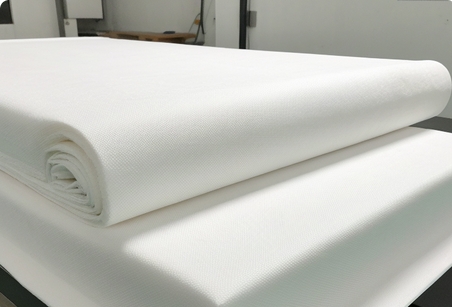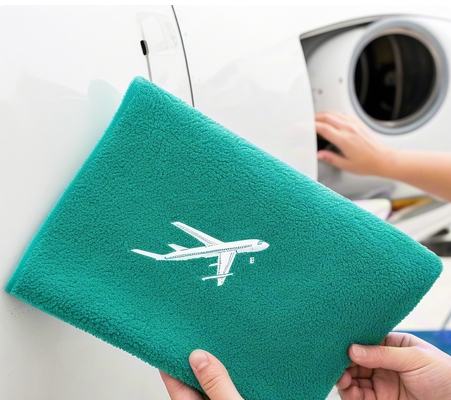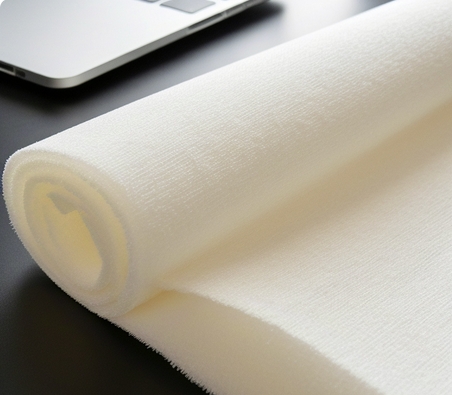Language

In the fields of precision manufacturing and microelectronics, dust-free cloths as key cleaning consumables directly affect process yield and product reliability. Its unique performance indicators and standardized usage processes are important guarantees for maintaining a clean room environment. This article will systematically analyze the professional technical points of dust-free cloth from three dimensions: material characteristics, operating specifications and unpacking process.
1. Analysis of the core performance of dust-free cloth As a special wipe material for clean rooms, dust-free cloth is usually made of composite fiber structures prepared by electrospinning process. The mainstream substrate ratio is polyester/nylon 8:2 mixed weaving, and the slitting and packaging is completed through ISO 5-level clean workshop. Its performance advantages are mainly reflected in four aspects:
2. Particle control technology: After IEST standard test, the release amount of particles per square foot of high-quality dust-free cloth is less than 200 (particle size ≥0.5μm). Product grading strictly corresponds to the clean room grade. For example, the level 10 dust-free cloth is suitable for semiconductor lithography areas, while the level 10,000-level products are mostly used in medical equipment assembly lines.
3. Chemical tolerance system: It has been verified by the ASTM F3150 standard and is compatible with 8 commonly used solvents such as isopropanol (IPA) and acetone. It is worth noting that a mixed solution of 70% IPA and 30% deionized water can significantly improve the decontamination efficiency, and this ratio has been widely used in OLED screen cleaning processes.
4. Fluid mechanical properties: The microfiber structure forms a capillary effect, and the typical water absorption can reach 0.8ml/cm². Taking wafer cleaning as an example, a single A4-sized dust-free cloth can absorb about 15 ml of cleaning liquid, which is equivalent to 3 times the capacity of traditional cotton cloth.
5. Mechanical durability index: After ASTM D4966 Martindale wear resistance test, high-quality products can withstand 5,000 friction cycles without causing fiber falloff, especially suitable for high-frequency operation scenarios such as CMP equipment wipe.
6. Before the operators of personnel protection standards system enter the clean area of 10,000, they must complete the third-level protection preparation: nitrile dust-free gloves (ASTM D6319 certification), FFP2 masks, and one-piece anti-static clothing. Tested data show that when the human body is not wearing gloves, the body releases about 10⁶ particles per hour, and standardized protection can reduce the amount of pollution to less than 200 per hour. For special operations such as lithography machine maintenance, a local cleanser needs to be equipped to form a micro positive pressure isolation area.
7. Process flow optimization solution. In the semiconductor packaging process, it is recommended to adopt a step-by-step wipe strategy: the first process is made of a thick rub using IPA-immersed reel dust-free cloth, and the second process is replaced with dry microfiber cloth for fine treatment. A memory chip manufacturer practices that this combination can reduce surface particle residue by 78%. When cleaning optical components, a "Z-shaped" one-way wipe method is recommended to avoid the risk of cross-contamination.
For different application scenarios, the selection of materials must follow specific standards: knitted fabric with a gram weight of 80g/m² should be used for cleaning photovoltaic cell cells, while woven models that require sterilization for maintenance of biopharmaceutical equipment. The pre-wet dust-free cloth (such as the 3M 6800 series) that has emerged in recent years has increased the IPA retention rate to 95%, which is particularly suitable for integrated use of automation equipment.
[Solvent Selection and Wiping Specifications] Professionals should pay special attention to solvent compatibility during the use of dust-free cloth. It is recommended to give priority to 99.7% purity IPA (isopropanol) or medical grade ethanol. These two solvents have passed ISO 14644-1 certification in the fields of semiconductors and precision instruments. Their volatility rate (IPA is 0.3g/m²·s at 20°C) can effectively avoid liquid residue. During operation, the dot dipping method (solution amount per square centimeter is ≤0.05ml) or complete dipping method can be used. The latter is recommended to use the centrifugal drying equipment to control the humidity at 65%±5%RH.
[Key points of wipe operation process] Contact surface management is the key to ensuring cleaning efficiency. The dust-free cloth with laser edge seal (edge melting thickness 0.2mm) needs to be folded into the cutting surface 3mm to form a protective layer, which is consistent with the anti-fall design recommended by the ASMR B72.01 standard. Pressure should be controlled within the range of 200-400gf/cm². Laboratory data show that exceeding this threshold will lead to an increase in the damage rate of edge sealing structure to 12%. It is recommended to use a three-finger grip method to maintain a 45° inclination angle for linear wipe.
[Principle of Motion Trajectory Control] One-way wipe paths can reduce the risk of cross-contamination by 98%, which has been verified in the wafer cleaning process. It is recommended to follow the "Z" or "spiral progressive" mode, covering 1/3 of the previous track with each move. It is worth noting that the American Association for Materials Testing ASTM E2090 pointed out that reciprocating wiping will increase the amount of particles redeposition by 37%.
[Fiber Contact Optimization Technology] In order to achieve 100% effective contact, a dust-free cloth with an appropriate gram of weight must be selected according to the surface roughness. For optical components with Ra≤0.8μm, it is recommended to use a 60g/m² plain weave structure; for mechanical components with Ra>1.6μm, 80g/m² satin weave fabric can be used. Experimental data show that appropriate pre-stretching treatment (elasticity 8%-12%) can increase the fiber contact area by 22%.
[Clean unpacking operation procedures] 1. The unpacking environment must reach ISO Class 5 (level 100) cleanliness, temperature control is 22±2℃ and pressure difference is maintained +15Pa. It is recommended to operate under the laminar flow hood, and the wind speed is controlled at 0.45m/s±10%.
2. The packaging pretreatment should be carried out in three steps: isopropanol atomization and disinfection → ultraviolet irradiation (254nm wavelength, 30 minutes) → positive pressure nitrogen purge. Pay special attention to the fact that the double-layer bagged products must be removed first.
3. When opening, use a titanium alloy unpacker to cut along the heat seal line, and the cut flatness error is ≤0.5mm. Statistics show that standardized operations can reduce the amount of particles to<5pcs/m³.
4. After unpacking, the material must be transferred to a storage cabinet with HEPA filtration within 30 seconds, and the relative humidity must be maintained at 40%±5%. It is recommended to use a vacuum suction cup clamp for contact transfer to avoid contact with naked hands.
In the field of precision manufacturing, dust-free cloth plays an irreplaceable role as a key consumable. This type of specially treated cleaning materials is mainly used in semiconductor production lines that require extremely high cleanliness, especially in core links such as wafer processing and chip packaging. Its electrostatic elimination ability and microfiber structure can effectively avoid residual particles on the product surface. Statistics show that the market size of dust-free cloth used in the global semiconductor industry has exceeded US$1.8 billion in 2023, confirming its important position in high-end manufacturing.
From the analysis of specific application scenarios, dust-free cloth mainly serves three categories of precision production environments: first, the field of microelectronics manufacturing, including integrated circuit production lines, lithography machine maintenance, and memory assembly processes; second, optical instrument manufacturing links, such as the wiping of high-precision lenses and cleaning of optical sensors; second, medical equipment production lines, especially in the process of CT scanner assembly and minimally invasive surgical instrument packaging, the cleanliness of dust-free cloth is directly related to the product qualification rate. Taking an international semiconductor manufacturer as an example, its 300mm wafer factory consumes 1,200 pieces of ISO Class 3 dust-free cloth per day.
It is worth noting that correctly grasping the use specifications of dust-free cloth is crucial to ensuring production safety.
Tags:
RELATED RESOURCES

What are the grades of industrial clean cloth?
The industrial dust-free cloth grade classification system is an important technical specification for clean e......
More

How to clean room with industrial dust-free cloth?
Guide to operating specifications for professional clean environment surface cleaningIn controlled environment......
More

How Aircraft Wipes Achieve Zero-Contamination Aircraft Engine Cleaning
Wipe star aviation-grade cleaning consumables are manufactured using innovative hydros pinning process, and th......
More

7 Questions on Selecting Ultrafine Dust-Free Wipes: Comparative Analysis of Ultrafine Fiber Cleaning
Comparative analysis of ultra-fine dust-free cloth and ultra-fine dust-free cloth: professional selection guid......
More
Related Products
Room 101, Building 1, Angeer Factory, No.4, Hetian Road, Shatian Community, Kengzi Street, Pingshan District, Shenzhen, Guangdong, P.R. China 518122
info@wipestar.com
+86-755-89616775
+86-755-89616773
Related Products
RELATED RESOURCES

What are the grades of industrial clean cloth?
The industrial dust-free cloth grade classification system is an important technical specification for clean e.........
More

How to clean room with industrial dust-free cloth?
Guide to operating specifications for professional clean environment surface cleaningIn controlled environment.........
More
WIPESTAR
微信官方公众号